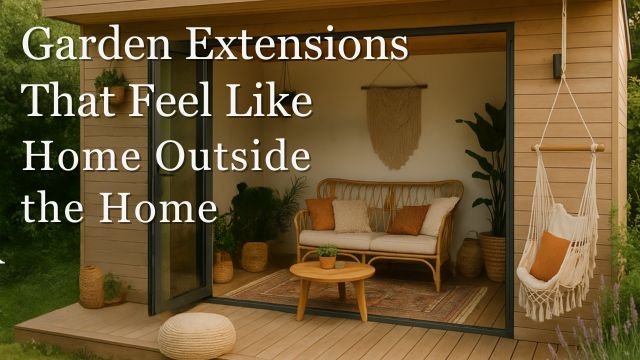There’s something quietly magical about garden extensions. Not just the structure itself, but what it means. It means you’ve taken your patch of green and turned it into a place where life happens—tea at sunrise, yoga before the emails start, a space where your world expands without needing to move house. Garden extensions aren’t about square footage, really. They’re about quality of life, and right now in the UK, they’re one of the smartest, most joyful upgrades homeowners can make.
A well-designed garden extension blends purpose with personality. It gives you that extra breathing room without digging out the loft or knocking through the kitchen. And it doesn’t have to be a huge undertaking. Whether you’re working with a compact London terrace or a generous back garden in Yorkshire, the goal stays the same: create a space that connects indoors and out, feels lived-in from day one, and works all year.
Why More UK Homeowners Are Turning to Garden Extensions
It’s not just about adding value anymore—although that’s a solid reason too. Rightmove reports that homes with quality outdoor rooms, garden studios, or extensions now fetch up to 8% more than similar listings without. But more than the resale, people want space that makes now better. Space to work without the sound of the dishwasher humming in the background, or a retreat that isn’t just the living room with the volume down.
Garden extensions hit that sweet spot between practical and aspirational. They don’t require full planning permission if you stay within the usual guidelines—under 30 square metres, under 2.5m tall at the boundary, and covering no more than half your garden. That means many builds fly under the red-tape radar and can be designed, approved, and built within weeks.
Add to that the fact that most of us are now hybrid working, juggling kids’ schedules, or craving a space that feels like ours alone, and garden extensions become more than just “nice to have”. They become essential.
Designing a Garden Extension That Works for You
The first step is always function. What will the space do for you? A garden extension can be anything: a reading den filled with morning light, a music room, a mini gym, a guest room, even a garden bar that flips open for summer evenings. Let that purpose guide the structure, the layout, and even the materials.
Next, look at position. The best garden extensions aren’t tucked away—they interact with the garden. Use sun path apps or just your own observation to figure out where the light falls, and think about orientation. Where will the door open? How close to the house should it be? Sometimes a tucked-away feel is lovely. Other times, a straight view from your kitchen adds connection.
Then come the foundations. You’ve got options. Concrete slabs are traditional and sturdy but take more time. Ground screws are gaining popularity for their eco profile and speed. Whatever you choose, make sure it’s raised enough to avoid damp and that any timber frame breathes properly.
For structure, SIP panels are a brilliant modern choice. They’re energy-efficient and fast to assemble. But classic timber framing is still very popular, especially when you want more control over detailing or are doing parts yourself.
Externally, cladding can totally shift the feel. Thermowood, larch, painted composite, even corrugated metal—each one tells a different design story. Internally, the same goes for walls. Ply and OSB bring a warm, tactile look. Plasterboard can be dressed like any room. Cork floors? Cosy underfoot and great insulation too.
Once the walls are up and the wiring’s in (don’t forget: run data cables and outdoor power while the shell’s open), you can move on to making it personal.
The Boho-Touched Details That Bring It to Life
Garden extensions don’t have to feel clinical. In fact, they shouldn’t. The most successful ones feel like they’ve grown with the garden. Layer textiles. Add an old kilim rug, woven floor cushions, throws from the market. Choose mismatched chairs, low rattan stools, a coffee table that’s also a footrest.
Lighting transforms everything. Solar string lights looped from beam to beam, a Moroccan-style lantern with a battery-powered bulb, a few soft-glow candles along the windowsill. Suddenly it’s golden hour, even in November.
Plants finish the space. Try placing trailing plants in macramé hangers by the windows, or fill pots with lavender, rosemary, and grasses just outside the door. For a Mediterranean vibe, go with terracotta. For desert-chic, use sculptural succulents and drought-resistant agaves. All of it wraps your structure in life and scent.
Cost Breakdown & Timeline
Here’s a rough sketch of what to expect. These are 2025 averages for UK garden extensions:
- Design & drawings: £1,500–£2,500
- Groundwork & base: £3,000–£4,000
- Frame & shell: £8,000–£10,000
- Doors, windows, cladding: £4,000–£6,000
- Electrics & insulation: £2,000–£3,500
- Interior finishes & styling: £1,000–£2,000
That puts a typical 12m² garden extension at around £20,000 to £28,000, depending on your choices. You can absolutely go leaner with DIY elements, or scale up with bespoke glazing and premium finishes. Many builds take 3–5 weeks from first dig to final styling.
Living With Your Garden Extension
The best part? It keeps giving. Whether you’re working from a sun-drenched armchair, reading by fairy light, or watching rain bounce off the window while wrapped in a throw, the space becomes a mood shift.
You’ll find excuses to use it. Winter writing mornings. Summer parties that spill outdoors. Quiet cups of tea when the rest of the house is noisy. It becomes a place where ideas land and shoulders drop.
Maintenance is low: a wipe-down of windows, oiling wood every couple of years, brushing off cobwebs, airing out soft furnishings. That’s it.
It’s funny. You might build it for one reason—work, maybe—and six months later it’s your meditation spot, your family game zone, your midnight think space. That’s the beauty of garden extensions. They evolve with you.


